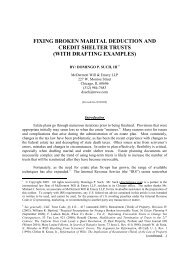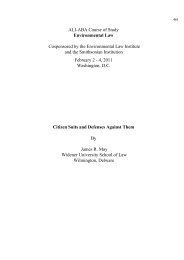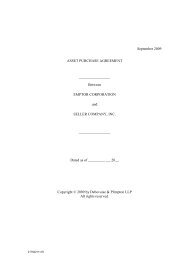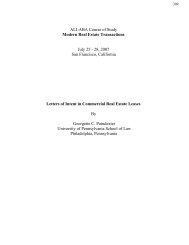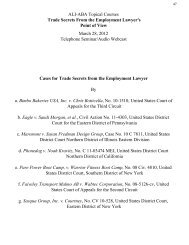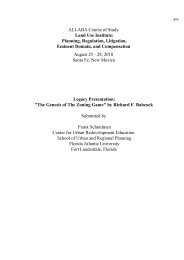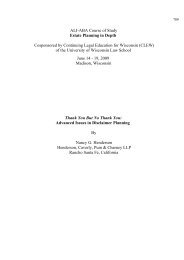ALI-ABA Topical Courses Trademark Law: What's New ... - ALI CLE
ALI-ABA Topical Courses Trademark Law: What's New ... - ALI CLE
ALI-ABA Topical Courses Trademark Law: What's New ... - ALI CLE
You also want an ePaper? Increase the reach of your titles
YUMPU automatically turns print PDFs into web optimized ePapers that Google loves.
4Although the first prong was easily satisfied, the second prong was a tougher play: Brownhad to show that EA’s use of the trademark explicitly misled consumers about the source orcontent of the work. Putting the second prong into context, the court stated that the relevantinquiry is whether people playing Madden NFL would be misled into thinking that Brown issomehow behind the game or is a sponsor of the product. The court held that, since neitherBrown nor his name or likeness are depicted on the game’s packaging or advertising, and hisvirtual athlete is anonymous and identifiable only by jersey number, it would require a “leapof logic” to conclude that the anonymous, misnumbered player’s presence in the gamesequates to Brown’s endorsement or an explicit attempt to convince consumers of hisendorsement. Thus, the court concluded that the second prong of the Rogers test was notmet, and Brown’s Lanham Act claim was barred by the First Amendment’s protection ofexpressive works.To further jump on the pile, because Brown’s Lanham Act claim did not survive thedismissal motion, the court declined to exercise supplemental jurisdiction over Brown’sremaining state and common law claims, since the district court no longer had a “hook” oforiginal jurisdiction for which to hang the supplemental jurisdiction.On July 6, 2010, Brown called for an instant replay review, and filed his appeal of the districtcourt’s decision with the United States Court of Appeals for the Ninth Circuit. Brown’sbrief, among other points, argues that the district court erred because in holding that thesecond prong of the Rogers test was not satisfied (i.e., that there were no explicitrepresentations of endorsement to cause consumer confusion), the court made its ownfinding of fact, and the issue should have been a matter for discovery. The brief also arguesthat EA’s misappropriation is actionable under every trademark-versus-free-speech approachadopted by the Ninth Circuit, including the Rogers test.EA went on the offensive and filed its answering brief on September 20, 2010, urging theNinth Circuit to affirm the dismissal order and reiterating most of the district courtarguments, including the application of the Rogers test. EA argued that if the court acceptsthe arguments in Brown’s briefs, “a broad range of expressive works might be subject toLanham Act claims,” and further urged the court not to turn trademark law into a “weaponfor prominent individuals to restrain the use of their name or likeness in expressive works.”- from Three Point Shot, “Illegal Procedure? Jim Brown Flags Electronic Arts forMisappropriation in Video Game,” November 2010, © 2010 Proskauer Rose LLPThe Brown case has been consolidated with the Keller case (below) on appeal to the Ninth Circuit Court ofAppeals. Oral argument was heard in both cases in February 2011 and a ruling on the appeal isforthcoming.




